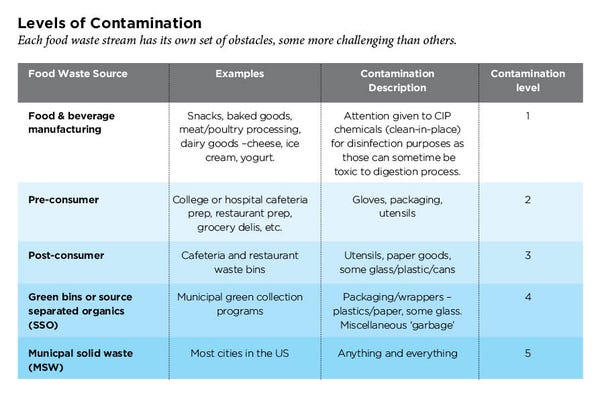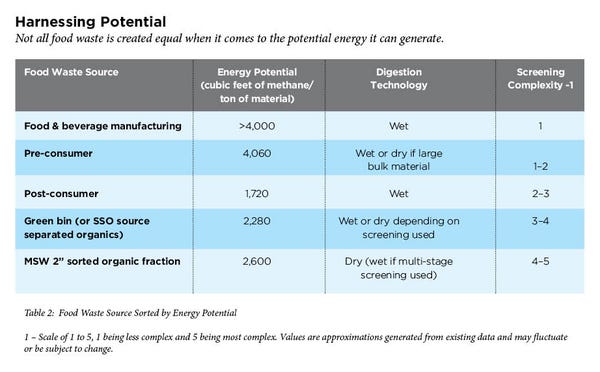Containing Food Waste Contamination Essential for Anaerobic Digestion
Wasted food is typically an excellent source of energy in an anaerobic digester. However, depending on its source, food waste can be highly contaminated with a variety of other materials. This contamination interferes not only with the good contact needed between bacteria and organic material, but can cause significant operational issues for digester components.
January 27, 2015
Christine McKiernan
Wasted food is typically an excellent source of energy in an anaerobic digester. However, depending on its source, food waste can be highly contaminated with a variety of other materials. This contamination interferes not only with the good contact needed between bacteria and organic material, but can cause significant operational issues for digester components.
Several states and major metro areas recently implemented bans on food waste going to landfills and, instead, indicated sending the discarded food to composting or anaerobic digestion operations. Wasted food is typically an excellent source of energy in an anaerobic digester. Anaerobic digestion relies on ancient bacteria from the Methanogenic Archaea domain of microbes which function in oxygen-free digesters. In this oxygen-free environment, bacteria can convert organic material into renewable energy in the form of methane. In order for these bacteria to convert food waste to energy, they must make good contact with the food for a sufficient period of time. However, depending on its source, food waste can be highly contaminated with a variety of other materials. This contamination interferes not only with the good contact needed between bacteria and organic material, but can cause significant operational issues for digester components.
Let’s consider a number of different sources for wasted food. Each food waste stream has its own set of obstacles, some more challenging than others. Referring to Table 1 below, different sources of food waste have been generally characterized by their level of contamination using a scale from 1 to 5, with 5 containing the most contamination:
Table 1: Food Waste Source Sorted by Contamination Level
The contamination level becomes more significant once food has gone through the hands of the consumer, and simple screening will often not suffice. Many institutions or commercial facilities implement educational programs encouraging consumers to dispose of food in specially marked bins—programs such as these can have a tremendous impact on contamination reduction.
Optimizing the energy potential of various wastes and their contaminants requires careful review and selection of appropriate digester technology.
Wet Vs. Dry Digester Technology
Digestion methodology is divided into two major categories: wet or dry fermentation. Wet digesters come in various configurations, such as complete-mix stirred, plug flow, mixed plug-flow, and variations of these. The primary distinguishing factor between the configurations is the percent solids, or %TS, that the digester operates at. Wet digesters typically handle input waste that is pumpable and operates anywhere from 7-15%TS. Even on the higher-solids end of the “wet digestion” spectrum with a 15%TS, the material is still fairly wet. (Note, discussion of wet digestion in this article does not include high rate digesters which operate at 1-2%TS).
Wastes with little contamination or requiring only simple pre-screening often make their way into wet digesters. One such scenario could involve screened and pulped waste collected from a university kitchen or a grocery store’s prepared foods kitchen. If available, these wastes could be combined with material from a nearby potato chip manufacturer. These combined wastes can easily be pumped into a wet digester and have the potential to produce significant volumes of methane for energy utilization.
Dry digesters, on the other hand, are typically batch operated tunnels or bays which operate with input material TS of 20% and higher. Feedstock or wastes loaded into a dry digester are typically stackable and cannot be pumped. Dry digesters are extremely useful in applications where liquid wastes are not available for creating pumpable slurries as is done in wet digestion.
Expired foods or reject produce from large grocers would be scenarios where dry digestion may be the best option; here, the waste itself can be made up of large items—i.e watermelons, heads of lettuce, ends of deli meats, etc. This type of stream lends itself to use in a dry digester where it is not necessary to pulp the material.
Municipal collection of green bins or municipal solid waste garbage bins typically result in the most contaminated streams. This waste material often contains a variety of contamination and requires the highest level of sorting and screening to produce a stream suitable for digester use; however, not all the contamination is removed.
Consider a typical collected garbage bag. Its contents may include glass bottles, plastic yogurt cups, batteries, assorted packaging, shoes, even electronics; glass might break, plastics may crack, and so on. Many of these inorganic materials will pose little problem as most modern waste receiving stations can remove metals with magnets, float out plastics, sort out large items, and screen small items down to 2 inches in diameter. The resulting 2-inch organic fraction—although still containing some glass or plastic, etc.—becomes quite suitable for use in a dry digester, since maceration and pumping are not required for the system. If wet digestion is to be used with 2-inch fraction, additional screening is required to protect equipment from the effects of excess ground glass, etc.
Understanding the Economics
Contamination levels not only can influence digester technology choices, but project economics as well. In Table 2 below, the various food waste sources are noted by their potential available energy. Potential energy is measured by a series of lab scale digestion tests called biochemical methane potential, or BMP; using data such as this is useful for project planning to begin understanding the potential economic benefits and which technology would be the best fit.
Table 2: Food Waste Source Sorted by Energy Potential

For example, if a project is to be developed using 5,000 tons per year of post-consumer waste plus another 10,000 tons per year of green bin waste, the expected energy output would be in the range of 600-650 kW or 45,000 to 50,000 MMBTU per year, (not including any thermal recovery from use of CHP genset). Depending on the market for this energy, the project may earn in excess of $500,000 per year in electric energy sales. However, these earnings must be weighed against the necessary infrastructure required to receive and prepare the food waste.
Christine McKiernan is the Vice President of Development and Technology of BIOFerm Energy Systems. She has been engaged in the water and wastewater arena for 28 years actively designing, constructing, operating, and troubleshooting projects in anaerobic and aerobic treatment. Through her participation in various projects and as Director of Engineering for Microgy, she oversaw the process design and technology evaluation, process troubleshooting, and project engineering. She has reviewed and designed anaerobic treatment facilities for the capture of methane from biogenic waste materials such as food processing waste, agricultural crops, and animal slaughter.

Wet Fermentation System, COCCUS
You May Also Like


